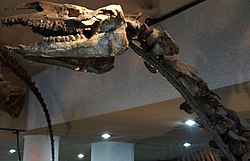Juxia: Difference between revisions
No edit summary |
No edit summary |
||
| Line 17: | Line 17: | ||
}} |
}} |
||
'''''Juxia''''' is an extinct [[genus]] of [[Indricotheriinae|indricothere]], a group of herbivorous [[mammals]] that are part of the odd-toed ungulate family tree of [[rhinoceros]] and [[tapir]]s. ''Juxia'' was in the size of a [[horse]]. It lived in [[Asia]] during the upper [[Eocene]]. As an early indricothere, ''Juxia'' had a relatively light body, held by elongated long legs and small skull firmly attached to a relatively long neck. Based on its triangular like teeth and sharp protruding incisors, ''Juxia'' was probably a strict browser, feeding on ferns and leaves on branches where most herbivorous mammals couldn't reach. In terms of habitat, ''Juxia'' lived in densely lush and tropical forests of what is now [[China]]. Though a few skeletons have been found, it is unclear whether this early indricothere was permanently solitary or lived in small social groups, possibly harems. Based on its morphology, ''Juxia'''s long legs probably enabled it to run relatively fast for a limited duration. This was probably a defense mechanism against early mammalian predators.<ref>{{cite book | last = Prothero | first = D. | title = Rhinoceros Giants: The Palaeobiology of Indricotheres| publisher = Indiana University Press | year = 2013 | edition = | location = Indiana | isbn = 978-0-253-00819-0}}</ref> |
'''''Juxia''''' is an extinct [[genus]] of [[Indricotheriinae|indricothere]], a group of herbivorous [[mammals]] that are part of the odd-toed ungulate family tree of [[rhinoceros]] and [[tapir]]s. ''Juxia'' was in the size of a [[horse]]. It lived in [[Asia]] during the upper [[Eocene]].<ref name="Chow et al. 1964">Chow Minchen and Chiu Chan-Siang: An Eocene giant rhinoceros. ''Vertebrata Palasiatica'', 1964 (8), 1964, S. 264–268</ref> As an early indricothere, ''Juxia'' had a relatively light body, held by elongated long legs and small skull firmly attached to a relatively long neck. Based on its triangular like teeth and sharp protruding incisors, ''Juxia'' was probably a strict browser, feeding on ferns and leaves on branches where most herbivorous mammals couldn't reach. In terms of habitat, ''Juxia'' lived in densely lush and tropical forests of what is now [[China]]. Though a few skeletons have been found, it is unclear whether this early indricothere was permanently solitary or lived in small social groups, possibly harems. Based on its morphology, ''Juxia'''s long legs probably enabled it to run relatively fast for a limited duration. This was probably a defense mechanism against early mammalian predators.<ref>{{cite book | last = Prothero | first = D. | title = Rhinoceros Giants: The Palaeobiology of Indricotheres| publisher = Indiana University Press | year = 2013 | edition = | location = Indiana | isbn = 978-0-253-00819-0}}</ref> |
||
==References== |
==References== |
||
Revision as of 03:21, 8 July 2014
| Juxia Temporal range:
| |
|---|---|

| |
| Skull and neck of a full mounted specimen fossil Juxia sharamurenense on display at the Paleozoological Museum of China | |
| Scientific classification | |
| Kingdom: | |
| Phylum: | |
| Class: | |
| Order: | |
| Family: | |
| Subfamily: | |
| Genus: | †Juxia Chow & Chiu, 1964
|
| Species: | †J. sharamurenense Chow & Chiu, 1964
|
Juxia is an extinct genus of indricothere, a group of herbivorous mammals that are part of the odd-toed ungulate family tree of rhinoceros and tapirs. Juxia was in the size of a horse. It lived in Asia during the upper Eocene.[1] As an early indricothere, Juxia had a relatively light body, held by elongated long legs and small skull firmly attached to a relatively long neck. Based on its triangular like teeth and sharp protruding incisors, Juxia was probably a strict browser, feeding on ferns and leaves on branches where most herbivorous mammals couldn't reach. In terms of habitat, Juxia lived in densely lush and tropical forests of what is now China. Though a few skeletons have been found, it is unclear whether this early indricothere was permanently solitary or lived in small social groups, possibly harems. Based on its morphology, Juxia's long legs probably enabled it to run relatively fast for a limited duration. This was probably a defense mechanism against early mammalian predators.[2]
References
- ^ Chow Minchen and Chiu Chan-Siang: An Eocene giant rhinoceros. Vertebrata Palasiatica, 1964 (8), 1964, S. 264–268
- ^ Prothero, D. (2013). Rhinoceros Giants: The Palaeobiology of Indricotheres. Indiana: Indiana University Press. ISBN 978-0-253-00819-0.
